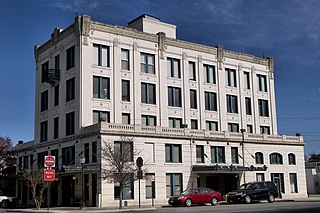
Seguin is a city in and the county seat of Guadalupe County, Texas, United States. The population was 29,433 at the 2020 census, and according to 2023 census estimates, the city is estimated to have a population of 36,013.

Ponferrada is a city of Spain, located in the autonomous community of Castile and León. Ponferrada, the second most populated municipality of the Province of León, is also the capital city of El Bierzo, the only comarca recognized as an administrative entity by law in the region.

Pedro Álvarez de Toledo y Zúñiga was a Spanish politician. The first effective Spanish viceroy of Naples, in 1532–1552, he was responsible for considerable social, economic and urban improval in the city and southern Italian kingdom in general. He was the father-in-law of Cosimo I de' Medici, Grand Duke of Tuscany.
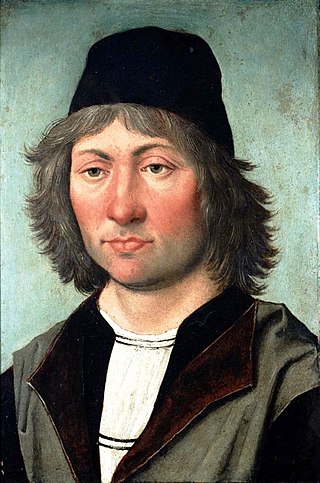
Pedro Berruguete was a Spanish painter whose art is regarded as a transitional style between Gothic and Renaissance art. Berruguete most famously created paintings of the first few years of the Inquisition and of religious imagery for Castilian retablos. He is considered by some as the first Renaissance painter in Spain.

Fructuosus of Braga was the Bishop of Dumio and Archbishop of Braga, also known for being a great founder of monasteries The son of a Visigothic dux in the region of Bierzo, at a young age he accompanied his father on official trips over his estates. After a period spent as a hermit, he established a monastery at Complutum and became its first abbot.

El Bierzo is a comarca in the province of León, Spain. Its capital is the town of Ponferrada. Other major towns are Bembibre and Villafranca del Bierzo, the historical capital.

Os Ancares is a comarca in the Galician Province of Lugo. The overall population of this local region is 13,888 (2005). It is formed by the municipality of Candín with two slopes, Sil and Navia, and separated by the Ancares pass.
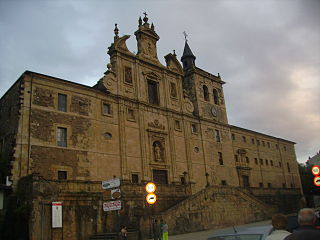
Villafranca del Bierzo is a village and municipality located in the comarca of El Bierzo, in the province of León, Castile and León, Spain.
Bercian is the generic name of the linguistic varieties spoken in El Bierzo region, in the province of León, Spain. They belong to the dialect continuum of Romance languages in northern Spain, linking the Galician and Leonese languages. Many of these varieties are on the brink of disappearing.

García Álvarez de Toledo y Osorio, 4th Marquess of Villafranca del Bierzo, was a Spanish general and politician.
FruelaDíaz, known in contemporary sources as Froila Didaci or Didaz, was a nobleman in the Kingdom of León, the dominant figure in the centre of the realm during the late reign of Alfonso VI and the early reign of Urraca. A man of great private wealth who expanded his landholdings through numerous purchases, he was able to marry royalty and maintain good terms with his sovereigns of León as well as the rulers of Galicia and Portugal, whose territories lay immediately to the west of his area of influence. He also founded a hospital, a traveller's inn and a settlement that grew into a town. His lands raised some of the most valuable horses in Spain, he was buried in the royal pantheon of the kings of León, and his high rank—highest in the kingdom after the king and the rulers of Galicia and Portugal—is remembered in the most famous of cantares de gesta.
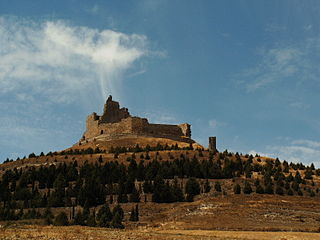
Nuño Pérez de Lara was a Castilian nobleman, politician and military leader. He began his career at the court of the Emperor Alfonso VII, during whose reign he took part in the repoblación of the Extremadura and the defence of the Almohad frontier. Between 1164 and 1169 he governed Castile as regent for the underage Alfonso VIII, and he continued to exercise semi-regal power in the kingdom until 1176. He founded two monasteries and fostered the cult of Thomas Becket in Spain. He died taking part in the conquest of Cuenca
Saint Gonzalo (or Gundisalvus) (c. 1040 – c. 1108), a medieval Galician nobleman and clergyman, was the long-serving Bishop of Mondoñedo from 1071. According to one modern source he was a brother of Pedro Fróilaz de Traba. If he was elected at the canonical age of thirty, he would have been born in 1040 or 1041, which would in turn support the contemporary contention that he was old in 1104–5, but cast doubt on his relationship with Pedro Fróilaz. Perhaps he was a more distant relative of the same family, the budding House of Traba.

Rodrigo Vélaz was the "count of Galicia, who held Sarria" according to the near-contemporary Chronica Adefonsi imperatoris. During his long public career he was the dominant figure in mountainous eastern Galicia while the House of Traba dominated its western seaboard. He served under three monarchs—Alfonso VI, Urraca, and Alfonso VII—and was loyal to all of them, never figuring in any rebellion. The contemporary Historia compostellana is a valuable source for his life, since there are no aristocratic archives surviving in Spain from this period. Rodrigo's career must be pieced together from the few references in the chronicles and the charters preserved in various ecclesiastical archives.

Ramiro Fróilaz was a Leonese magnate, statesman, and military leader. He was a dominant figure in the kingdom during the reigns of Alfonso VII and Ferdinand II. He was primarily a territorial governor, but also a court figure, connected to royalty both by blood and by marriage. The military exploits of his sovereigns involved him against both the neighbouring kingdoms of Navarre and Portugal and in the Reconquista of the lands of al-Andalus.

Suero Vermúdez was an Asturian nobleman, territorial governor, and military leader. His career was marked by loyalty to the crown of León-Castile during the reigns of Alfonso VI, Urraca, and Alfonso VII. He never took part in any revolt, but fought in many wars against rebels, against rivals, and against the Moors.

Valerio of Bierzo was an ascetic hermit and monk from the Bierzo region of Visigothic Spain. A number of his writings still survive, including three short autobiographical works in which he complains about his many sufferings.
Diego was the Bishop of León from 1112 or 1113 until his deposition in 1130. He succeeded his uncle Pedro, whose episcopate, and life, had ended in exile after the Battle of Candespina (1111). After a brief usurpation by Archbishop Maurice of Braga, Diego was elected to replace Pedro.
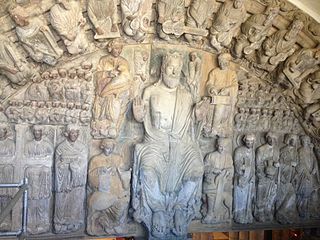
Pedro Suárez de Deza was a Spanish prelate, the bishop of Salamanca from 1166 until his transfer to the archbishopric of Santiago de Compostela in 1173, where he remained until his death. In 1183 he served as chancellor of the kingdom of León. Of his stature in the Leonese kingdom, Roger Wright claims that he "would probably be now ... widely celebrated ... if he had only had a biographer", like his predecessor, Diego Gelmírez, did.
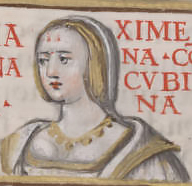
Jimena Muñoz or Muñiz was a noblewoman from the El Bierzo region of the medieval Kingdom of León, and the mistress of king Alfonso VI of León and Castile during the late 1070s and early 1080s. By him she was mother of two countesses and grandmother of Afonso I, first king of Portugal.















